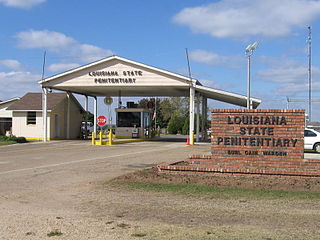Related Research Articles

Capital punishment is a legal punishment in Louisiana.
Capital punishment is a legal penalty in the U.S. state of Arkansas.

In the U.S. state of California, capital punishment is a legal penalty. However it is not allowed to be carried out as of March 2019, because executions were halted by an official moratorium ordered by Governor Gavin Newsom. Prior to the moratorium, executions were frozen by a federal court order since 2006, and the litigation resulting in the court order has been on hold since the promulgation of the moratorium. Thus, there will be a court-ordered moratorium on executions after the termination of Newsom's moratorium if capital punishment remains a legal penalty in California by then.

Capital punishment is a legal penalty in the U.S. state of Nevada.

Capital punishment is a legal penalty in the U.S. state of Ohio, although all executions have been suspended indefinitely by Governor Mike DeWine until a replacement for lethal injection is chosen by the Ohio General Assembly. The last execution in the state was in July 2018, when Robert J. Van Hook was executed via lethal injection for murder.
Capital punishment is a legal penalty in the U.S. state of Utah.
Capital punishment in the state of Washington was abolished on October 11, 2018 when the state Supreme Court ruled it was unconstitutional as applied. On September 10, 2010, Cal Coburn Brown became the last person to be executed in Washington State before it was abolished in 2018.
Capital punishment is a legal penalty in the U.S. state of Nebraska. In 2015, the state legislature voted to repeal the death penalty, overriding governor Pete Ricketts' veto. However, a petition drive secured enough signatures to suspend the repeal until a public vote. In the November 2016 general election, voters rejected the repeal measure, preserving capital punishment in the state. Nebraska currently has 12 inmates on death row.
Capital punishment is a legal penalty in the U.S. state of Oklahoma.

Capital punishment in Alabama is a legal penalty. The state has the highest per capita capital sentencing rate in the United States. In some years, its courts impose more death sentences than Texas, a state that has a population five times as large. However, Texas has a higher rate of executions both in absolute terms and per capita.
Capital punishment is a legal penalty in the U.S. state of Idaho.
Capital punishment is a legal penalty in the U.S. state of Wyoming.
Capital punishment is a legal penalty in the U.S. state of South Dakota.

Capital punishment is a legal penalty in the U.S. state of Florida.
Capital punishment is a legal penalty in the U.S. state of North Carolina.
Capital punishment is a legal penalty in the U.S. state of Georgia. Georgia reintroduced the death penalty in 1973 after Furman v. Georgia ruled all states' death penalty statutes unconstitutional. The first execution to take place afterwards occurred in 1983.
Capital punishment in Delaware was abolished after being declared unconstitutional by the Delaware Supreme Court on August 2, 2016. The ruling retroactively applies to earlier death sentences, and remaining Delaware death row inmates had their sentences commuted to life imprisonment. Despite this, the capital statute for first-degree murder under Title 11, Chapter 42, Section 09, of the Delaware Code has yet to be repealed, though it is unenforceable.
Capital punishment is a legal punishment in Tennessee.
Capital punishment is a legal punishment in Pennsylvania.
Capital punishment is a legal penalty in the U.S. state of Kentucky.
References
- 1 2 3 "Missouri". Death Penalty Information Center. n.d. Retrieved February 2, 2022.
- ↑ "Trial procedure, first degree murder". moga.mo.gov. Retrieved April 9, 2017.
- ↑ "Executive Clemency". doc.mo.gov. Retrieved April 9, 2017.
- ↑ "Death penalty--manner of execution--execution team to be selected, members, confidentiality". moga.mo.gov. Retrieved April 9, 2017.
- ↑ Missouri Revised Statutes § 565.032
- ↑ "Missouri Capital Punishment Laws". statelaws.findlaw.com. Retrieved April 9, 2017. (Code Section)
- ↑ "Missouri Death Row: History". Archived from the original on December 26, 2009. Retrieved July 2, 2015.